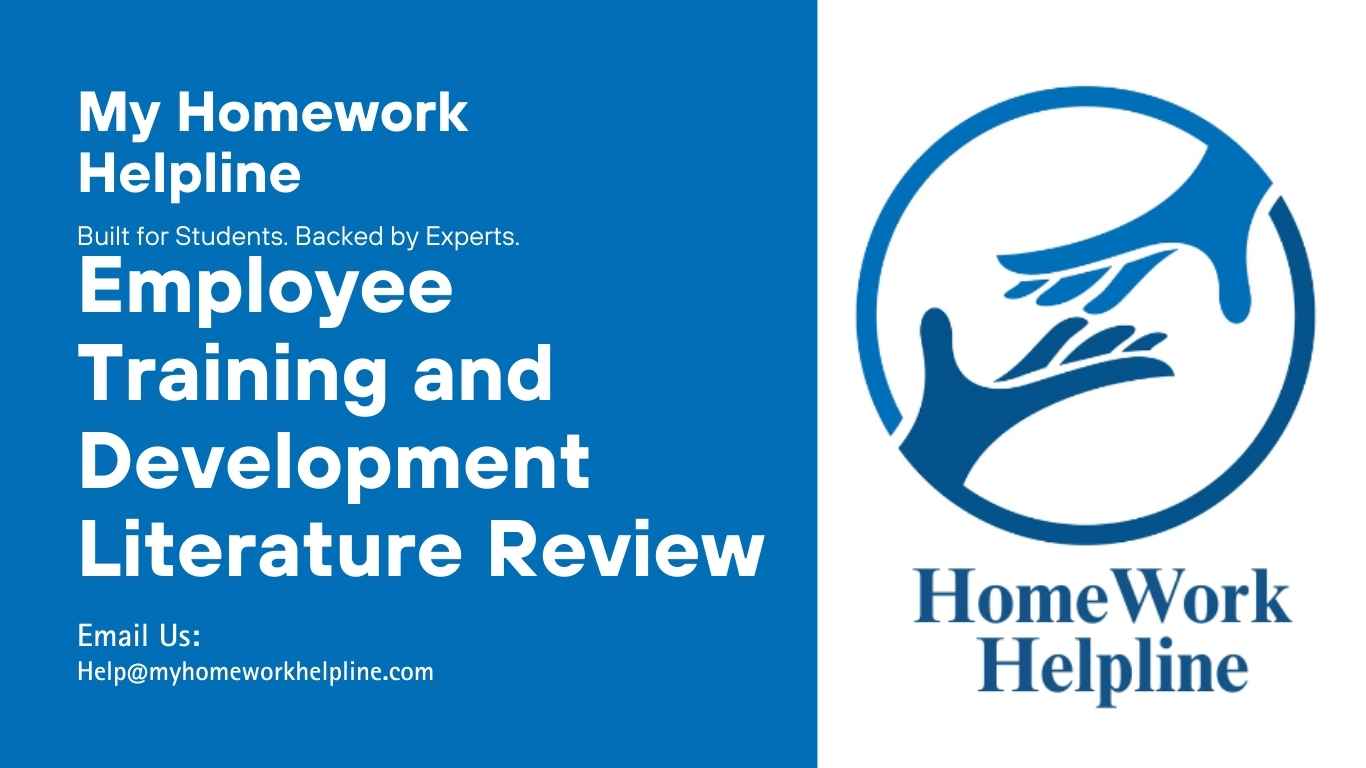Comprehensive Literature Review on Employee Training and Development
Training and development (T&D) is not new; it has evolved into its modern form since the beginning of human civilization. Training and development became a priority for the United States government after World War II (Torraco, 2016). The demand for trained workers skyrocketed throughout this period because of the expanding wartime economy and the development of new technologies. During this period, efforts to train and develop workers grew in scope and intensity. The human resources of a business may improve in its current and future roles thanks to training and development initiatives. Consequently, there will be an uptick in efficiency, efficacy, and enthusiasm. The benefits of training programs are similar to those of acquiring new knowledge or enhancing current ones. Training significantly boosts employee motivation (Younas et al., 2018). Most employees are motivated by the knowledge that their superiors appreciate their effort. Employees are responsive to training incentives that are related to attainable career goals.
Need help crafting a strong literature review or academic paper on management topics? With expert support from My Homework Helpline, you can simplify complex assignments and access professional homework assistance tailored to your coursework. Our team helps you produce polished, insightful work that boosts your academic success. Get the guidance you need today and excel in your research projects with confidence.
A company will continue to operate and grow if it successfully makes a profit in its current market, but it might not do so if it is not. Human and material infrastructure degradation is far worse (Salas et al., 2012). Training is necessary for regular workers and executives to achieve success via diversity and competition. The benefits are borne solely by workers and private firms. With this initiative, businesses want to raise their workers’ marketability and standard of life (Kaymaz, 2010). The instructions and training of workers may be successful with the involvement of the stakeholders. Staff training aims to assist workers in succeeding in their present positions and prepare them for future advancement (Sung & Choi, 2018). The purpose of workforce development is to ensure that firms have the resources they need to achieve their goals and objectives by recruiting, developing, and keeping the most talented individuals across all business areas. Employees are given access to the most effective training and development programs in the business to help them advance in their chosen fields and reach their full potential as individuals (Shuck et al., 2011).
Tannenbaum and Yukl (1997) argue that various training and development strategies should be investigated. The combination of their chosen approach and prior exposure to huge enterprises has led them to this realization. The selection of workers, keeping the uncertainty relevant to the aim, and introducing new techniques for the working environment are all obstacles that the existing conventional training constantly faces. Since organizations have realized this, they have been advising on every issue, highlighting adaptability’s significance. Managers often get to decide which training and development programs are ideal for their teams, but they should be mindful of the five points raised by Miller and Desmarais to improve their odds of success (2007). Davenport and Brooks (2006) argue that web-based strategy tools make it simple to implement plans. A robust online learning program is becoming increasingly vital as organizations implement a remote workforce strategy (Kaufman et al., 2020). However, the move beyond conventional classroom learning would involve a reevaluation of present methods to training and development. Covid-19 increased a developing trend toward working remotely. A corporation may build team activities that link distant employees or utilize simulations to foster creative problem-solving and critical thinking among learners (Kaufman et al., 2020). Besides, employees may enhance their proficiency in the technical aspects of their professions via specialized training. Technology, goods, sales strategies, customer service methods, and more may all be covered in training. Soft talents may be used in any industry, whereas technical abilities are industry specific.
Workers nowadays are hesitant to join a company that does not invest in expanding their horizons professionally. Corporate training is changing dramatically in this regard. Many companies provide learning opportunities since they are effective in retaining employees. Significant shifts are occurring in the prevailing attitudes and values that shape training and development in the workplace. According to Suhasini and Suganthalakshmi (2015), technological developments—particularly the computer and the internet—significantly impact organizational training. In their piece, they explained how training has progressed up to the current day. The writers further shared their thoughts on the latest ICT developments in the classroom. Job rotation is one form of training and development employed by many companies in this age of globalization (Ongori & Nzonzo, 2011). Accordingly, training program patterns are evaluated using a variety of methodologies and tactics to ensure that workers are prepared to adapt to new circumstances in the workplace. According to Bhatia and Kaur’s (2014) study, there is significant utility in training procedures all over the globe. It also attempted to analyze the existing training state and predict future developments worldwide.
It is essential to make the most of every asset at our disposal, from money to people, to thrive in today’s dynamic environment. First, we can contend with cutting-edge manufacturing tools and facilities by investing heavily in modernizing our hardware components. The ability of businesses to tap into the modern information landscape must match their own (Sewell & Taskin, 2015). Human capital is the fulcrum on which all other actions are built. This is where the company can make a difference in people’s lives, careers, and businesses. Organizational effectiveness may be enhanced via human resource training and development that helps workers perform to their full potential (Nda & Fard, 2013). Training should be procedural in that it is developed, organized, and delivered in response to well-articulated requirements. Expert trainers must provide it, and the training results should be thoroughly examined.
One of the biggest problems with training is that it often fails to meet the workforce’s needs (Towett & Oino, 2020). The company may provide generic training unrelated to the employee’s work, or the training may emphasize the employee’s strengths rather than their development areas. Businesses frequently struggle to solve the problem of poor employee engagement in training because it is pervasive (Vance, 2006). CEOs should also keep in mind that training is a mutually beneficial process. Managers may provide opportunities for employees to learn, but employees must take advantage of them. Furthermore, workers will lose motivation to acquire new skills if they are not provided with support from management. A productive reaction requires management to routinely check in with staff members after training sessions (Bouskila-Yam & Kluger, 2011). Therefore, performance reviews should include employee growth. In addition, some businesses are afraid to invest in training due to its high cost. Hiring a training consultant or enrolling in a formal training program is prohibitive for many small firms. Notably, animation, equipment, location rental, and participant time all contribute to the high price tag of training.
There has been a noticeable void in the training and development discourse regarding training and development policy. A company’s values and culture may be reflected in its training and development strategy, which is rooted in principles that govern its approach to human resource management and employee growth. The company’s concept and strategy for its investment in its personnel may be better communicated to workers and management via this policy. According to Yadapadithaya and Stewart (2003), the design should consider that businesses must compromise between satisfying shareholders and encouraging workers to unleash their full potential. Staff and supervisors should be able to see the thought process behind and justification for training and development allocations in the policy. The policy should also emphasize that all employees working part-time or temporarily have access to training and development opportunities. Any auditing or benchmarking of actions concerning the delivery of training and development may be done quickly with the help of a well-defined training and development policy (McGrath, 2012).
Up to this point, the analysis has shown that training is valuable to a business, has a goal, and increases output. The crux of what is required in terms of training has also been covered. It was not forgotten to discuss how and why training requirements should be evaluated. Training methods are classified according to their general purposes and the primary criteria for selecting trainees. Human Resource Management (HRM) policies and procedures sometimes need a shift in company culture or the introduction of new ways of doing things at work. Training is often seen as an essential tool in making these shifts happen. To begin, the company needs a training policy that outlines the parameters for employee training, including what counts as “training,” who is eligible to participate, and how often and where training will take place. The next stage is to compare and contrast the company’s strategy with the demands of the people working inside the plan.
References
Bhatia, A., & Kaur, L. (2014). Global training & development trends & practices: an overview. International Journal of Emerging Research in Management & Technology, 3(8), 77-78.
Bouskila-Yam, O., & Kluger, A. N. (2011). Strength-based performance appraisal and goal setting. Human Resource Management Review, 21(2), 137-147.
Davenport, T. H., & Brooks, J. D. (2004). Enterprise systems and the supply chain. Journal of Enterprise Information Management.
Kaymaz, K. (2010). The effects of job rotation practices on motivation: A research on managers in the automotive organizations. Business and economics research journal, 1(3), 69-85.
Kaufman, E., Lovich, D., Bailey, A., Messenböck, R., Schuler, F., & Shroff, A. (2020). Remote work works–where do we go from Here. BCG.
McGrath, S. (2012). Building new approaches to thinking about vocational education and training and development: Policy, theory and evidence. International Journal of Educational Development, 32(5).
Miller, D., & Desmarais, S. (2007). Developing your talent to the next level: Five best practices for leadership development. Organization Development Journal, 25(3), P37.
Nda, M. M., & Fard, R. Y. (2013). The impact of employee training and development on employee productivity. Global journal of commerce and management perspective, 2(6), 91-93.
Ongori, H., & Nzonzo, J. C. (2011). Training and development practices in an organisation: an intervention to enhance organisational effectiveness.
Salas, E., Tannenbaum, S. I., Kraiger, K., & Smith-Jentsch, K. A. (2012). The science of training and development in organizations: What matters in practice. Psychological science in the public interest, 13(2), 74-101.
Sewell, G., & Taskin, L. (2015). Out of sight, out of mind in a new world of work? Autonomy, control, and spatiotemporal scaling in telework. Organization studies, 36(11), 1507-1529.
Shuck, M. B., Rocco, T. S., & Albornoz, C. A. (2011). Exploring employee engagement from the employee perspective: Implications for HRD. Journal of European Industrial Training.
Suhasini, R., & Suganthalakshmi, T. (2015). Emerging trends in training and development. International Journal of Scientific and Research Publications, 5(3), 1-10.
Tannenbaum, S. I., & Yukl, G. (1992). Training and development in work organizations. Annual review of psychology, 43(1), 399-441.
Torraco, R. J. (2016). Early history of the fields of practice of training and development and organization development. Advances in Developing Human Resources, 18(4), 439-453.
Towett, Geofrey & Oino, Peter. (2020). Challenges Constraining Effective Employees’ Training in Eldoret Municipal Council in Kenya.
Vance, R. J. (2006). Employee engagement and commitment. SHRM foundation, 1, 53.
Yadapadithaya, P. S., & Stewart, J. (2003). Corporate training and development policies and practices: a cross‐national study of India and Britain. International Journal of Training and Development, 7(2), 108-123.
Younas, W., Farooq, M., Khalil-Ur-Rehman, F., & Zreen, A. (2018). The impact of training and development on employee performance. IOSR Journal of Business and Management (IOSR-JBM), 20(7), 20-23. https://www.academia.edu/download/57021484/D2007042023.pdf

